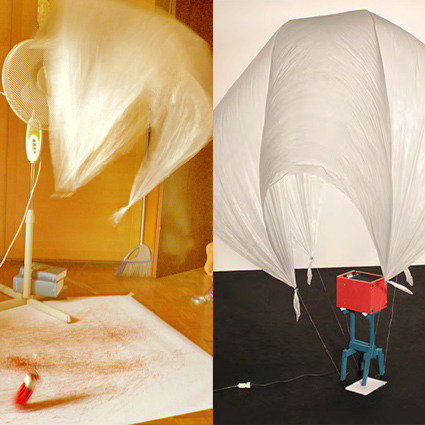12/3/2013
Antonio Guiotto and Manuel Larrazabal Scano
Anyspace, Bruxelles
Co|oc is born from a dialogue between Francesca Chiacchio and Michela Sacchetto. They have put Scano's and Guiotto's artistic practices together because of a euphoric intuition, that of promoting the encounter, in the same space, of the anarchist machines of the former and the funambulist creations of the latter. Makes them implode in a random motion.

The gallery hosts the project co|oc inviting Italian artists Manuel Larrazábal Scano and Antonio
Guiotto to present an artistic process of cohabitation.
Michela > We have put Manuel Larrazábal Scano’s and Antonio Guiotto’s artistic practices
together because of a euphoric intuition, that of promoting the encounter, in the same space, of
the anarchist machines of the former and the funambulist creations of the latter. The dialogue
that has since taken place is one between devices experimenting the power relationship between
certain elements and the space containing them. These elements are the objects, sculptures and
drawings, the sounds that they produce or contain and the interaction that keeps them balanced
or makes them implode in a random motion.
The elaboration of a form of balance is present throughout Antonio Guiotto’s works, which, like
funambulists, reestablish their center of gravity in relation to the space in which they take
position. This research is visible in the series of support systems, constituted by casts of domestic
objects, as well as by the machines made from instruments and waste materials of constructions
sites, solidly anchored to the ground. In his latest works, Antonio builds devices diffusing sound
frequencies picked for their therapeutic effect on the people surrounding them. These anthropo-
morphous constructions whisper or whistle the intimately recomposed stories that have
generated them, those of the artist, even of art itself.
Francesca > Antonio Guiotto’s last work appears to be producing the paradox of stability
generating movement, even though at times it only is purely cerebral movement. Hominid
sculptures, creators of balance, occupy the space in which they operate. It almost seems as though
they entered in a tight group, like a team of construction workers at the crack of dawn, dividing
up the walls and corners that will be their work for the day. They replace columns and buttresses
of old times. And even though this action is seemingly useless, it becomes necessary in order to
stop the frenzy of our everyday activities, which make us indifferent to the details of architecture;
this action stresses the walls of the gallery having been painted countless times, or those at home
eternally waiting to be painted...
But when one’s attention is awakened by the movement produced by external objects, one can
be filled with pleasure... when, in those hot summer days, the air finally moves thanks to the fans
hanging from the ceiling, or when the blender is activated to bring pleasure to our taste buds...
Or when the washer lets us know that it’s almost done and, as it does so, it throws on the ground
the wooden spoon left on the kitchen top which, in turn, causes the water in Rover’s bowl to spill,
as it falls in it from above. When these weak and mechanic movements follow one another in a
random manner, they produce a noise and sort of melody and a dance without a rhythm, making
us all happy in some way.
Observing these ordinary and every day like mechanisms, pushing to the extreme their movement
and thus overpowering the utilitarian rules of engineering is how Manuel Larrazábal Scano has
fun. What he produces are useless machines, indistinct accumulations of waste materials that can
fall to the ground and break, instruments able to grind the plaster on the wall through the
rotational motion of a drum stick glued to a second-class fan, that can also generate colorful
scribbles on a piece of paper... To be concise: real mechanisms that are fully defunctionalized.
Michela > Manuel’s installations and drawings are like music scores made of pencils, pieces of
wood, threads, waste, fragments and mechanic elements that are put in action in a reiterated
motion. The scores are created through superimposition, accumulation and repetition of simple
gestures impressed upon paper and upon the space. Each repetition produces another repetition,
in a spontaneous automatism, which generates twelve-tone chords. Manuel’s compositions inte-
grate within themselves randomness, revealing the process of auto-organization which brings the
balance between order and chaos.
Francesca > This cohabitation between Antonio and Manuel in Anyspace’s space takes the shape
of an essay on movement, in which the chapter on statics has been written with a pen and a mixer,
and the chapter on centripetal movement with a ruler.
co|oc is the proposition for a dialogical project which takes the form of an artistic cohabitation in a
given space. Two artists are invited to share a space of creation. The notion of space is each time
redefined and it can either be a physical space or a real or imaginary situation. co|oc invites two
artists to travel with a simple piece of hand luggage and spend a short time in a city where they
have never been exposed, in order for them to reconsider the notion of creative process and its
formalization.
The first conversation is between Manuel Larrazábal Scano, Antonio Guiotto and Anyspace Gallery.
co|oc is born from a dialogue between Francesca Chiacchio and Michela Sacchetto.
The
residency begins march 13rd
Opening of the exhibition march 21st 2013, 6 - 9 p.m.
anyspace
59 rue Van Eyck straat B-1050 Brussels
THURSDAY to SATURDAY 14-18H or BY APPOINTMENT



